Plotting The Pathway of Destruction
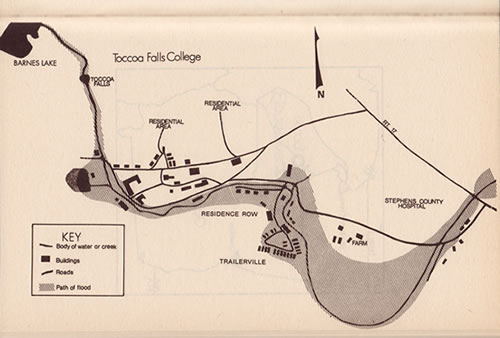
(Map is from Dam Break in Georgia, © 1978, Horizon House Publishers, Camp Hill, PA 17011)
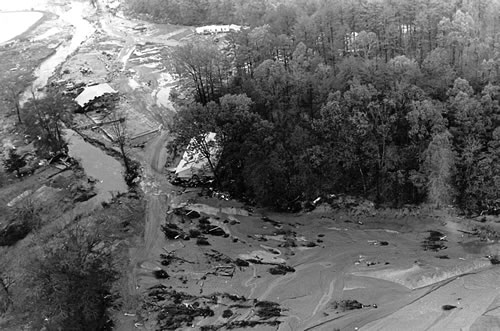
Saturday, November 6, 1977
9:00 p.m. — Members of the Toccoa Falls Volunteer Fire Department became concerned about the rising waters of Toccoa Creek. A lot of rain had fallen and the atmosphere of the usually peaceful seemed to be changing. 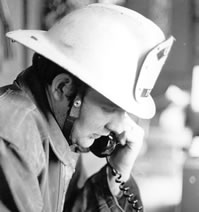
10:30 p.m. — Ron Ginther and David Fledderjohann took the Toccoa Falls Volunteer Fire Department truck up to the dam and visually inspected the water level of Kelly Barnes lake. The water appeared to be below danger level and there was no water running down the road. They radioed back by CB that the dam was solid and there appeared to be no need for concern or alarm.
11:30 p.m. — Mrs. Decie Fowler, mother-in-law of Roy Gaines, the mayor of Toccoa, had just died. Drivers of the hearse from the funeral home in Royston had come to pick up her body, and were the last to drive across the Highway 17 bridge that spans Toccoa Creek.
Sunday, November 7, 1977
12:15 a.m. — Security guard Jim Conaway called Eldon Elsberry concerned about the rising water. By this time others of the Volunteer Fire Department had gathered to assess the situation.
1:10 a.m. — D. Pinney left the Ginther’s trailer, where he had been working on a CB radio and headed toward upper campus. When he got to the bridge near Trailerville the lights went out on lower campus.
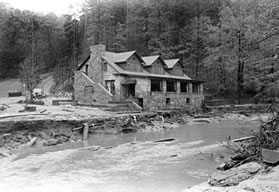 1:25 a.m. — As Pinney neared Forrest Hall, he saw turbulent water ahead on the road near Gate Cottage. Backing up, he tried to turn around to warn people that the dam had broken. With water already in the floorboard of the car and no longer able to see the road, he left his vehicle and headed for the hill near Stewart Hall.
1:25 a.m. — As Pinney neared Forrest Hall, he saw turbulent water ahead on the road near Gate Cottage. Backing up, he tried to turn around to warn people that the dam had broken. With water already in the floorboard of the car and no longer able to see the road, he left his vehicle and headed for the hill near Stewart Hall.
1:35 a.m. — Someone began ringing the old school bell in an effort to wake up the college’s sleeping students and warn them of the danger. The electricity was out and there was no other way to sound the alarm. Therefore, Pinney made his way to the firehall and drove the fire truck to the hospital, which is located on land bordering that of Toccoa Falls. At the hospital, he called the Toccoa Fire Department and told them that the dam had broken. Shortly after he had placed his call, volunteer fireman Eldon Elsberry, covered with mud, walked through the hospital door.
1:40 a.m. — Emergency medical technicians with the Stephens County Memorial Hospital on the other side of Toccoa were contacted by radio in the ambulance reporting that the dam had broken. Shortly after, Toccoa police arrived at the Highway 17 bridge where EMTs had already pulled a woman out of the water. No one knew how structurally sound the structure was or if it had been seriously damaged.
1:45 a.m. — The dispatcher at the Stephens Country jail was notified of the flood who immediately radioed the information to patrolling deputies and called Sheriff Don Shirley at his home. Fred Purdy, Toccoa Stephens County Civil Defense Director, received a call from the Toccoa Police Department about the dam break at Toccoa Falls. 
2:00 a.m. — Sheriff Shirley and several county deputies arrived at the bridge. By 2:20 a.m., Civil Defense Unit leaders and volunteer rescue also arrived.
2:30 a.m. — Groups of volunteers from neighboring Georgia counties began arriving to give assistance. The Toccoa rescue squad was joined by the Toccoa Civil Air Patrol and members of the local civil defense office.
3:00 a.m. — The Salvation Army moved in with the supply of coffee, food, and aid for victims and searchers followed by the Red Cross. Several private contractors had volunteered heavy machinery and personnel to begin clearing debris. Greg Bandy and other searchers entered Forrest Hall and discovered one of the first victims of the flood.
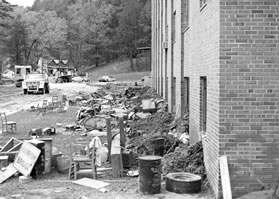 4:00 a.m. — The process of moving survivors out of the area had almost been completed. By daylight, news had spread about the disaster and offers of help began pouring in from around the world. First reports of those who had died in the flood or were missing at ten, but that number soon grew to 15, then to 20, and finally 39.
4:00 a.m. — The process of moving survivors out of the area had almost been completed. By daylight, news had spread about the disaster and offers of help began pouring in from around the world. First reports of those who had died in the flood or were missing at ten, but that number soon grew to 15, then to 20, and finally 39.
By mid-morning — Governor George Busbee, dressed in Army fatigues, toured the devastation. He was joined by a host of reporters from all over the nation. The governor officially declared Toccoa to be in a state of emergency. In Washington D.C., First Lady Rosalyn Carter made preparation to fly to Toccoa for a tour and to meet with survivors.
Noon on November 6 — Rescue workers had compiled an accurate list of the dead and missing.
3:00 p.m. — Mrs. Carter arrived to tour the disaster area and visit with those who had been injured in the flood.
4:00 p.m. Students meet with college president Dr. Ken Opperman, who told them the school would be closed until November 15. Many residents of TFC were housed in nearby Georgia Baptist Assembly Conference Center at Lake Louise. Some were taken in by residents of Toccoa and others left Toccoa to be with their families.
5:30 p.m. — The last of the 38 bodies was found. The body of the 39th victim, “Uncle†Paul Williams was not found until almost a month later.
Monday, November 8, 1977
President Jimmy Carter declared Toccoa as a national disaster area.
(Taken from the booklet In Darkness and Dawn and complied from eyewitness accounts, news reports, and other sources.)
Those who lost their life the night of the flood include:
- Karen Anderson and her children Joey and Becky. They were residents of a section of campus known as Trailerville. They were survived by husband and father Bill Anderson.
Gerald Brittin, a student living in Forrest Hall.
Bill Ehrensberger, his wife Peggy and their children Robert, Kristin, and Kenny. One son, Tommy, survived the flood. They lived on Residence Row.
David Fledderjohann, a staff member and volunteer fireman was survived by his wife, Margaret, and two sons. They lived off campus.
Mary Jo Ginther and daughters Brenda, Rhonda, Nancy, and Tracy. They were survived by husband and father Ron Ginther. They lived in Trailerville.
Cary Hanna, a student who lived in Forrest Hall.
Tiep Harner and son Robbie were survived by husband and father Robert Harner. They lived in Trailerville.
Chris Kemp lived in Trailerville and was survived by his parents Dixie and Thurman Kemp.
Cass Metzger and son Dirksen survived by husband and father Jerry Metzger and lived in Trailerville.
Ruth Moore and son Jeremiah. They were survived by their husband and father Mike Moore.
Edward Pepsny, his wife Carol and children Bonnie and Paul. Their home was the first on Residence Row.
Eloise Pinney survived by her twin brother D. Pinney. She shared a trailer with her brother in Trailerville.
Monroe Rupp survived by his wife Bea Rupp. They lived in Trailerville.
Jerry Sproull and children Joanna, Jocelyn and Melissa survived by wife and mother Patricia Sproull. They lived in Residence Row
Rick Swires, a Forrest Hall dorm student.
Jaimee Veer, a 21-month old baby who was survived by her parents Doug and Sue Veer.
Paul and Mary Williams. Both were TFC staff members and lived on Residence Row.
Betty Jean Woerner and daughter Deborah survived by husband and father Ray Woerner. They lived on Residence Row.
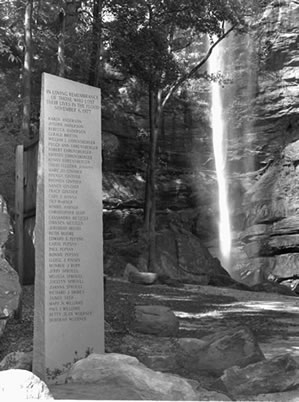
The Atlanta Journal reported the following: “The death toll climbed relentlessly, but inside the dark, damp chapel survivors sang praises to the Lord. In religious testimonies, they recounted losses of friends, colleagues, and possessions. . . . In the wake of Sunday’s devastating losses, one student after another said that the tragedies were beginning to look like fragments of a divine design. “We don’t understand the meaning of it all or the purpose of it. But we feel very strongly that God is in control,†said A. J. Moser, vice president and dean of the college.
| Section 3, A Week Later | Section 5, Photos |
